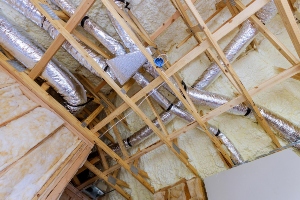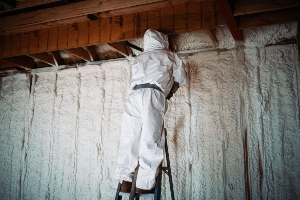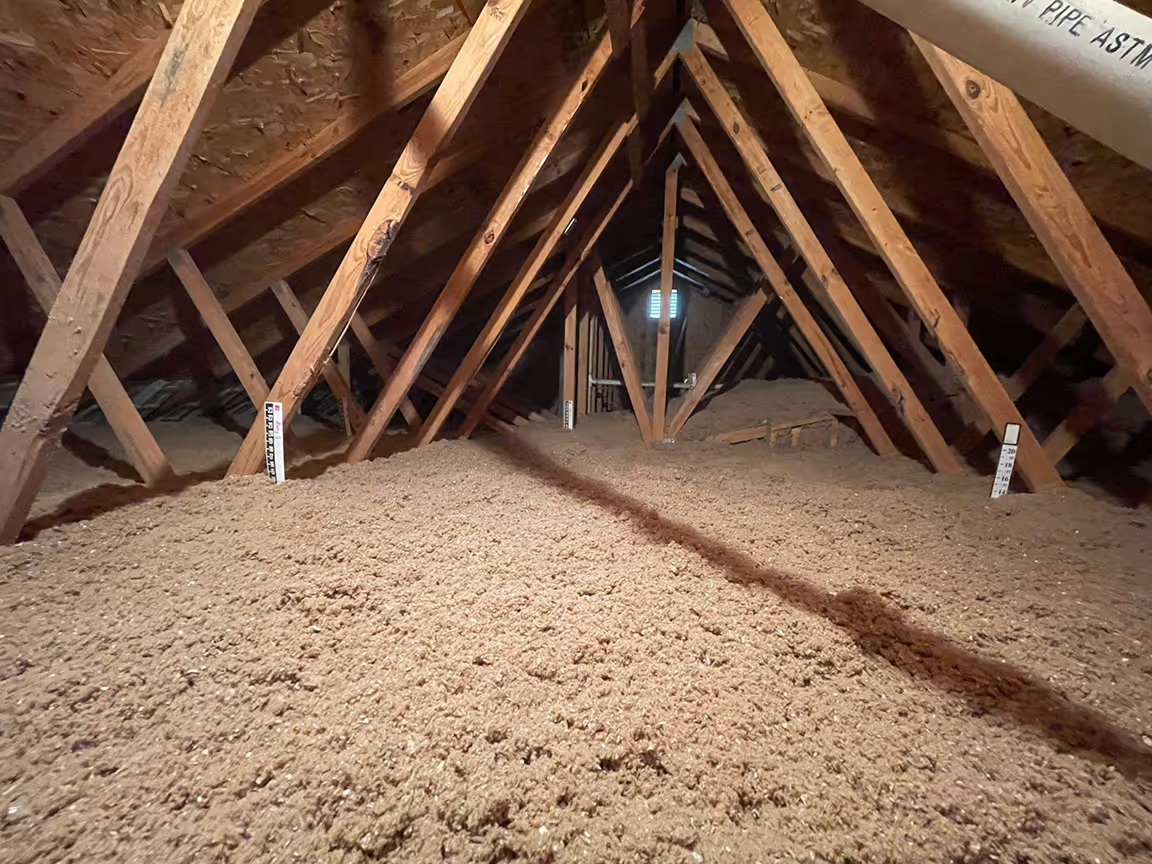Yes, you can over-insulate your home. While proper insulation creates an energy-efficient space, excessive insulation can prevent necessary air circulation. This lack of airflow may lead to moisture buildup, potentially causing mold problems and affecting indoor air quality.
It’s important to find the right balance, and the optimal amount of insulation varies based on your climate, home design, and ventilation systems. Working with professionals can help you maximize comfort and energy savings without creating new problems from over-insulation.
Understanding Home Insulation
Home insulation plays a crucial role in maintaining comfortable temperatures and energy efficiency. Proper insulation creates a barrier that reduces heat transfer between your home and the outside environment.
Types of Insulation Materials
- Fiberglass insulation is one of the most common types, made from fine glass fibers. It typically comes in batts or rolls and works well in unfinished walls, floors, and ceilings.
- Cellulose insulation consists of recycled paper products treated with fire-retardant chemicals. It’s often blown into wall cavities and attics, providing excellent coverage in hard-to-reach areas.
- Spray foam insulation expands upon application to fill gaps and create an air barrier. Available in open-cell (lighter, less dense) and closed-cell (denser, higher R-value) varieties, it’s effective for irregular spaces.
- Rigid foam insulation panels offer high insulating value per inch of thickness. These boards come in different types: Polyisocyanurate (highest R-value), extruded polystyrene (moisture-resistant), and expanded polystyrene (most affordable).
- Mineral wool, made from rock or slag, provides good fire resistance and sound absorption properties alongside thermal insulation.
Insulation and Energy Efficiency
Insulation effectiveness is measured by R-value, and the higher the value, the better the material resists heat flow. Proper insulation can reduce energy consumption by 20-30%, which translates to lower utility bills and a decreased carbon footprint. The payback period for insulation investments typically ranges from 1-5 years, depending on local energy costs and existing insulation levels. Most homeowners see immediate comfort improvements and gradual energy savings.
Air sealing works hand-in-hand with insulation, as even the best insulation loses effectiveness when air leaks exist. Identifying and sealing gaps around windows, doors, and utility penetrations maximizes insulation performance.
Role of Insulation in Home Comfort
Insulation creates a temperature buffer that keeps homes warmer in winter and cooler in summer. This consistent indoor climate eliminates uncomfortable hot and cold spots throughout the house. Attic insulation particularly affects comfort since heat naturally rises in winter, and attics can become extremely hot in summer. Proper attic insulation prevents these temperature extremes from affecting living spaces.
Insulation also provides sound-dampening benefits, as it reduces noise transmission between rooms and from outside sources, creating a quieter, more peaceful home environment. Moisture control is another important function. Well-designed insulation systems include vapor barriers that prevent condensation within walls and attics, reducing mold risk and structural damage.
Optimal Insulation Practices
Finding the right amount of insulation for your home requires a balance between energy efficiency and proper ventilation. The goal is to create a comfortable living environment while avoiding potential problems from over-insulation.
Assessing Insulation Needs
Every home has unique insulation requirements based on its location, design, and climate zone. Start by checking your current energy bills to establish a baseline. Higher than average costs often indicate insulation problems.
Key factors to consider:
- Climate zone (colder climates require higher R-values)
- Age of existing insulation
- Home construction type
- Local building codes
Signs that you need more insulation include uneven temperatures between rooms or drafty areas. A simple test is to touch your walls on cold days – if they feel cold, you likely need additional insulation.
Professional Insulation Inspection
Hiring a certified energy auditor provides the most accurate assessment of your home’s insulation needs. These professionals use specialized equipment like infrared cameras to identify problem areas.
Professional inspectors can determine not only if you need more insulation but also the correct type for each area. This prevents over-insulation while maximizing energy efficiency. They can also identify potential moisture issues that might worsen with additional insulation.
A thorough inspection should include:
- Blower door tests to measure air leakage
- Thermal imaging to find insulation gaps
- HVAC system evaluation
- Attic and crawl space assessment
Air Sealing and Insulation
You should complete air sealing before adding new insulation as this prevents moisture problems and improves overall efficiency. Remember to maintain proper attic ventilation even with increased insulation. This balance keeps air flowing while maintaining thermal efficiency.
Air sealing priorities:
- Attic penetrations (light fixtures, pipes)
- Window and door frames
- Basement rim joists
- Exterior wall penetrations
When installing insulation, follow manufacturer guidelines for thickness and coverage. Pay special attention to areas around HVAC equipment, leaving proper clearance to prevent overheating.
Potential Risks of Over-Insulation
While proper insulation saves energy and improves comfort, going too far with insulation can create unexpected problems in your home. These issues primarily relate to moisture control, ventilation, and the balance between insulation and other home systems.
Reduced Airflow and Moisture Control
Excessive insulation can significantly reduce natural airflow in your home. When a house becomes too tightly sealed, moisture from cooking, showering, and even breathing has nowhere to go. This trapped moisture can lead to condensation on walls, windows, and within the insulation material itself.
In over-insulated homes, we often see mold and mildew growth in corners, closets, and behind furniture. These issues can damage your sheetrock and compromise indoor air quality. Consider mechanical ventilation systems if you have high insulation levels. These systems provide fresh air exchange without sacrificing energy efficiency.
Proper moisture control requires a balance between insulation and ventilation. Attic fans help remove humid air, but they can’t work effectively if excessive insulation blocks soffit vents or other air pathways.
Insulation and HVAC Overload
Your heating and cooling systems were sized for your home’s original insulation levels, and adding significant insulation without adjusting your HVAC can cause problems. Over-insulated homes may experience HVAC short-cycling, where your air conditioning turns on and off frequently. This happens because the system cools the space too quickly in a super-insulated environment. Short-cycling reduces efficiency and wears out equipment faster.
High-efficiency furnaces sometimes can’t properly vent combustion gases in over-insulated homes. This creates a potentially dangerous situation. An HVAC professional should evaluate your system after major insulation upgrades. You might need to resize equipment or adjust airflow to match your home’s new thermal characteristics.
Structural Issues from Improper Insulation
Installing too much insulation in the wrong places can create structural problems, as heavy insulation in attics can overload ceiling joists if not distributed properly. Moisture trapped by excessive insulation can also damage roof rafters and shingles from underneath. In cold climates, you may see ice dams forming on roofs of over-insulated homes due to uneven heat distribution.
Blown-in insulation that blocks soffit vents reduces air circulation in the attic. This trapped heat and moisture can warp roof sheathing and shorten the life of your roof shingles. When insulating, maintain proper clearance around recessed lights, chimneys, and exhaust fans. Too much insulation pressed against these fixtures creates fire hazards and reduces their functional lifespan. Get in touch to arrange an energy audit of your home to assess its current insulation.





